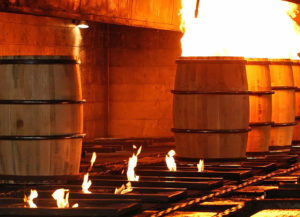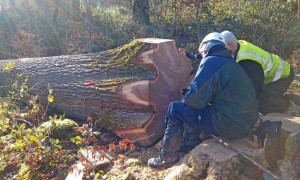What Goes Into A Bourbon Barrel
By Richard Thomas

(Credit: Brown-Forman)
One of the things I am continually surprised to discover about whiskey fans is how little they most of them know about the (apparently humble) bourbon barrel. Enthusiasts of all stripes can speak intelligently about the arcane intracacies of still design, mash bills and even yeasts, but know their knowledge of whiskey wood remains strangely absent. This is all the more surprising, because, depending on what distillery is in question, the cask contributes between 40 and 80% of the end profile.
This is not merely an American issue either, for on the other side of the Atlantic ex-bourbon barrels account for the overwhelming majority of casks used to age Irish Whiskey and Scotch Whisky. Those fans know their sherry casks, sure, but they neglect their staple American Standard Barrels (ASBs). It’s pretty much universal: too many enthusiasts are focusing on only half the story as to why their favorite tipple looks, smells and tastes the way it does.
What Is A Bourbon Barrel Anyway?
Under Federal law, bourbon barrels are made from new oak, invariably white oak or quercus alba, a species prevalent in the eastern half of North America. Compared to other species of oak, white oak is noted for its particularly intense character, such as its ability to produce a strong vanilla-sweet flavor.

(Credit: Richard Thomas)
Aside from the wood, there is no other mandated requirement. Bourbon barrels come in a range of sizes, but the overwhelming majority are 53-gallon American Standard Barrels (ASBs), the bedrock of the big distilleries in Kentucky, Tennessee and Indiana.
Barrel Timber
Most of the coopering timber used in making these barrels comes from a geographical band running right through the middle of the eastern United States, encompassing states like Missouri, Kentucky, Ohio, West Virginia, Tennessee and Alabama. This region has more or less the same growing season, so the wood from one part of the band is rather similar to the wood from another.
Timber drawn from Minnesota, Vermont, Maine or even Canada, however, was grown in a colder climate, with a shorter growing season. Consequently, the wood has a tighter grain than more southerly white oak, and that has the effect of restricting the absorption of those tannins, vanillins and other wood factors. A barrel made by a big cooperage may, from time to time, wind up with a stave or two from a northerly, outlier forest, whereas a small cooperage in Wisconsin might make barrels using entirely local wood sources.
Oak trees harvested for coopering are typically between 80 and 120 years old, and only the upper trunks of the straightest trees can be used for coopering timber. One tree typically provides enough timber for two or two and a half ASBs.
Staves
After harvesting, the oak timber is split into staves and seasoned (dried). ASBs are made using kiln-dried wood, a process that prepares the wood for coopering in a matter of weeks, whereas seasoning in the open air takes 18 to 36 months. Kiln drying is more economical, but doesn’t soften the tannins in the wood the way slower air seasoning does.
However, not all bourbon is aged in ASBs fashioned with kiln-dried wood. American craft distillers often use barrels smaller than the 53-gallon standard, and some use barrels (of various sizes) made from “wine quality,” air seasoned wood. A few craft distillers even buy new 59-gallon wine barrels made with air-dried American oak, and adapt these to maturing whiskey.
Most experts believe the drying issue, kiln- vs. air-dried, only matters for the first use of the barrel. Ergo, the question of how the staves were dried matters little or not at all to the barrel’s reuse in the Scotch, Irish, and Japanese whiskey industries.
Charring
After the wood had been split into staves, dried, and assembled into a barrel, the interior must be toasted or charred. This is done in the main because heating causes a partial breakdown of wood substances like hemicellulose, lignin, tannins and oak lactones, but also because the resulting charcoal removes impurities from the spirit stored in the barrel.
Generally speaking, the more you torch the inside of a barrel, the more hemicellulose caramelizes and turns to wood sugars; the more lingin converts to vanilla, spice and smoky “barrel char;” the mellower the tannins become; and less the oak lactones make the spirit woody/coconutty. Charring is the norm in the bourbon industry, but sometimes barrels are toasted, especially for the second round of a double oaked bourbon.
Charring is denoted in levels, with the most common being Char #3 (45 seconds of torching) and #4 (55 seconds), the latter commonly known as “alligator char” for the scaly appearance it leaves on the inside of the barrel. Lighter or heavier levels of char are, like toasting, not unheard of, but not standard practice either. After this heating, barrel assembly is completed and the new, charred (or toasted) white oak barrel is ready to be filled.




Thanks for a very informative article, Richard. I believe there is a primary error, however. The federal regulations only require “oak containers,” and I’m pretty sure they do not dictate the variety, hence the use of other regional oaks by some distillers.
True, but as a practical matter this can get into (and already has) a back and forth about species and such. I know of cases where the TTB has gone both ways, in their usual way. Since it’s apparently up for interpretation, the only sure fire way to clearly steer into safe territory is new white oak. In lieu of new language from Congress or a court ruling, what Federal agencies actually do in practice are what really matters, a point that is true for all manner of industries. If 99.998% of all barrels are white oak, and the authorities may or may not give you a regulatory headache about the remainder…
And THAT rather technocratic discussion is a bit much for a primer on barrels!